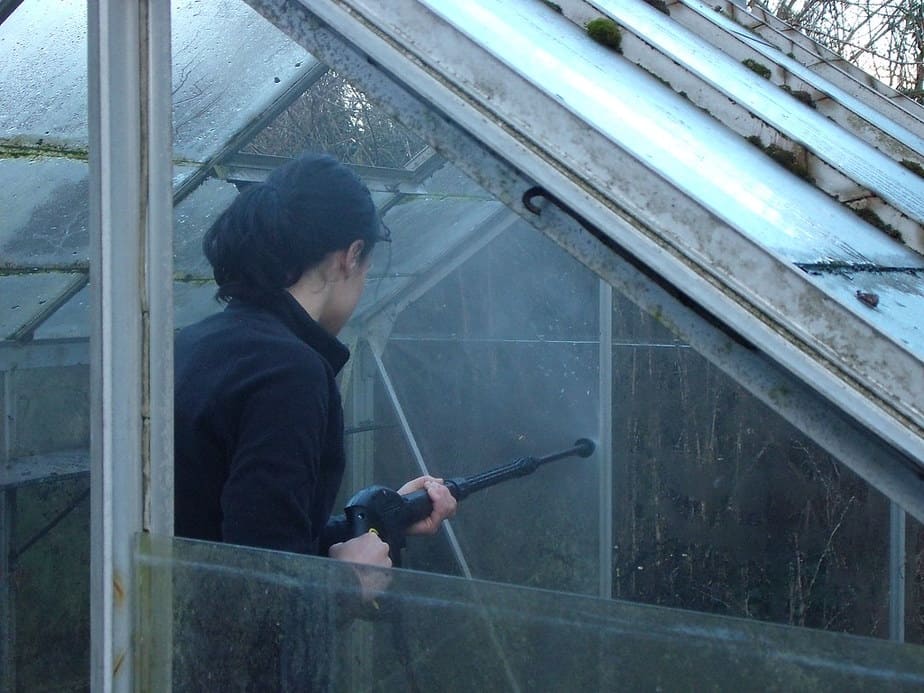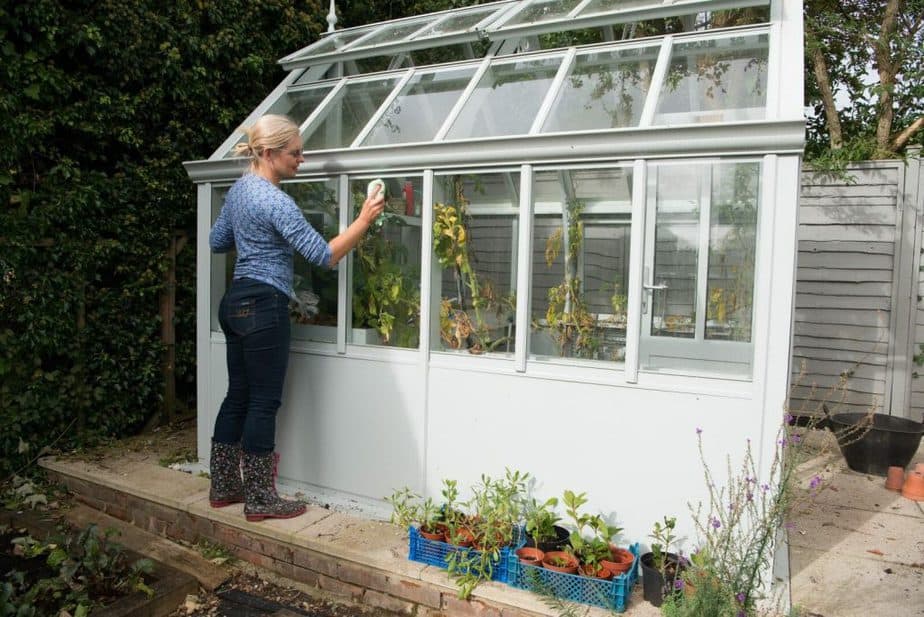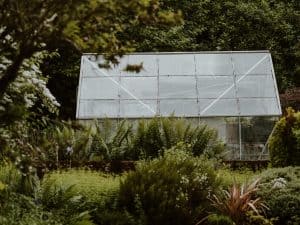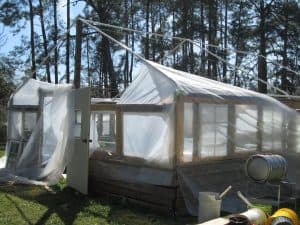Every gardener knows the value of maintaining a clean greenhouse. While it may not be fun or glamorous, it’s an important part of keeping your plants healthy and thriving.
Routinely cleaning your greenhouse also helps eliminate pests and diseases. Both are much easier to nip in the bud before they turn into a full blown infestation.
So, find a reasonable day this winter season, roll up your sleeves, and head outside to deep clean your greenhouse.
5 Steps to Deep Clean a Greenhouse

Follow these five steps to get the most out of your cleaning process.
Greenhouse Cleaning Supplies
Here are the supplies you’ll need to clean your greenhouse:
- A broom, rake, or shop vacuum
- A hot water soapy solution
- A greenhouse disinfectant
- An oxygen bleach solution
- Other items, like a sponge, small shovel, hose, gardening gloves, etc.
Step 1
First, you need to move everything out of the greenhouse. This includes pots, tools, hoses, shelving, and other items that may be lingering around.
Sanitize them using hot soapy water. You should also use an oxygen bleach solution. One gallon of water mixed with ¾ cup oxygen bleach should do the trick.
If the weather is super cold outside, place your plants in a garage or shed for protection. Another option is to wrap them in a fleece blanket to keep them warm until you’re done cleaning.
Step 2
Turn off all the electricity in the greenhouse. Make sure there are no machines, such as heaters, plugged in.
Take them outside if possible. If you can’t move them, cover them in a waterproof tarp for protection during the cleaning process.
Step 3
Once everything has been moved out of the way, remove weeds and plant debris. The next step is to begin at the top and work your way down.
For the windows and glazing, use a soft sponge and hot soapy water. Remember to use a natural and gentle soap wash. It shouldn’t leave behind any residue or remnants that can harm the plants.
You can also use an oxygen bleach solution, similar to what you used for the tools, pots, and shelving. Next, use a shop vacuum or a broom to clear away spilled dirt and other wayward remains. If things are going to get super soapy, then consider doing the sweeping first.
Step 4
Subsequently, you need to remove grime, fertilizer residue, and algae. The best way to do that is either with a power wash or by scrubbing everything off. Do this for the walls and pathways as well.
To remove mold, use vinegar. Pour vinegar into a spray bottle. Then, spritz wherever you find mold.
You can also use special sanitizers to get rid of the pests and critters hiding away in any nooks or crannies. Don’t forget to wash out pots, benches, and shelves before using any disinfectants.
These chemical disinfectants put an end to all types of diseases, such as Pythium root rot. They also help eliminate insects, mold, and bacteria.
Most disinfectants contain chemicals that kill off algae. Algaet acts as a breeding ground for shore flies and fungus gnats, which destroy plants from the roots up.
Any good disinfectant should contain one or more of these ingredients:
- Alcohol: It’s potent enough to kill microbes on contact. Alcohol is also used to sterilize tools and equipment. However, it’s volatile, so it loses its potency after some time.
- Hydrogen dioxide: This disinfectant eliminates bacteria and microbes. It’s also good for sanitizing workbenches and tools.
- Quaternary ammonium compounds: QACs are the most long-lasting of all the sanitizers. This makes them the most effective in the long run.
- Chlorine bleach: The most common disinfectant, bleach is also the most affordable. Remember to dilute it before using: one part bleach to nine parts water.
Step 5
Finally, it’s time to put everything back in its place. Keep the greenhouse well-ventilated to allow it to dry off.
Throw out old soil, as it may be contaminated. Replace it with new, disease-free soil. You may want to install a weed barrier at this time. Not only will it slow down weed growth, but it’ll also make the next clean-up task quicker and less of a hassle.
The Best Time to Clean a Greenhouse

Knowing when to clean is just as important as knowing how to deep clean a greenhouse. The following paragraphs shed light on when you should clean your greenhouse.
Windows and Glazing
Greenhouse windows and glazing should be cleaned twice a month. This helps prevent dirt build-up and grime.
If the windows and the greenhouse cover are dirty, sunlight won’t be able to fully enter the greenhouse. As a result, plant growth won’t be optimal. Some may even start to wilt and die.
The Interior
As for the actual greenhouse itself, you should deep clean it at least once a year, preferably twice. The best time is in the spring or fall in-between crop cycles.
If you have perennials that grow year-round, cleaning should be done in the fall. This is when they go through their mild spells, so moving them won’t be much of a problem.
Greenhouse Maintenance Tips
Once the greenhouse is spic and span, it’s vital to keep it that way for as long as possible for the sake of your plants. Follow these simple tips to minimize clean-ups in the future.
- Wash containers, equipment, and gardening gloves immediately after use
- Wash your hands before coming in contact with plants, soil, and equipment
- Raise hoses off the ground, especially the nozzle end
- Choose a pair of footwear to be used only inside the greenhouse
- Avoid wearing brightly colored clothing, which can attract insects into the greenhouse
- Remove diseased plants and weeds periodically
- Repair broken or cracked glass panes or glazing
A Final Note

Use our full guide on how to deep clean a greenhouse to get everything sanitized and ready for your new crop cycle. It’s quite an undertaking, but taking the time to maintain a sanitized greenhouse is crucial for the health of your plants.
It’s one of the best ways to ensure your crops are sure to grow, survive, and thrive. It’s also an effective way of preventing diseases, insects, and algae from taking over your greenhouse.




